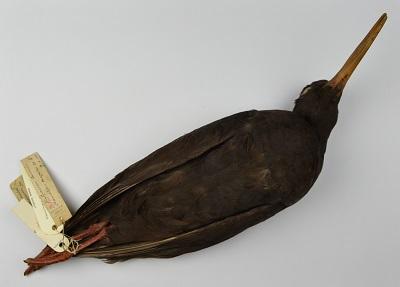Extinct or indistinct? The Canary Islands Oystercatcher

Among World Museum’s zoological treasures is our collection of extinct birds. Many of these extinct birds are island species such as the Dodo, the Green Spotted Pigeon, and the Lord Howe Island group of endemic birds, found only on small islands and nowhere else in the world.
The number of extinct birds from islands reflects the uniqueness and vulnerability of island populations inhabiting isolated and relatively small habitats. A combination of overharvesting local food resources, the introduction of cats and rats, and direct hunting by humans is often thought to be the cause of these extinctions. This is the case with the Canary Islands Oystercatcher.
The Canary Island Oystercatcher was thought to have gone extinct by 1940, although there have been unconfirmed sightings by birdwatchers in the 1960s and 1980s. The species was subsequently only known from eight specimens held in museums – one in World Museum, two in Manchester Museum, two in the Zoological Research Museum Alexander Koenig in Bonn, Germany, and three in the British Natural History Museum in Tring, including the last known specimen collected in April 1913.
The Canary Islands Oystercatcher in World Museum (number T16000) was collected by Edmund Gustavus Bloomfield Meade-Waldo from the Canary Island of La Graciosa in 1890. The specimen came to World Museum as part of a large collection of birds purchased by the museum from Canon Henry Baker Tristram in 1896.
The distinctness of the Canary Islands Oystercatcher has been the subject of controversy since it was first scientifically described in 1913. It was first thought to be a subspecies of the African Oystercatcher (Haematopus moquini), then a subspecies of the Eurasian Oystercatcher (Haematopus ostralegus), then a distinct species – Haematopus meadewaldoi. The African and Canary Islands Oystercatcher are both all-black while the Eurasian Oystercatcher is black-and-white. However, colour can be variable among Oystercatcher species and might not be a good indicator of evolutionary “distinctness” and therefore species status.
DNA analyses might have resolved the question of the Canary Islands Oystercatchers’ distinctness once and for all. In 2018, Dr Alexander Lees from Manchester Metropolitan University visited World Museum to take DNA samples from our Canary Islands Oystercatcher while researchers also collected samples from Canary Islands Oystercatchers in Manchester Museum and Tring. The team sequenced and compared short regions of DNA from the museum samples with fresh samples from African and Eurasian Oystercatchers collected in the wild. The DNA sequences of the Canary Islands Oystercatcher were found to be very close (in some cases identical) to those of the Eurasian Oystercatcher – so close they could be considered to be the same species. The results have recently been published in the scientific journal Ibis.
A similar conclusion had been reached by Dr Arturo Valledor de Lozoya, whose Spanish team sampled DNA from our oystercatcher in 2012 and published a monograph on the Canary Islands Oystercatcher in Spanish.
Labels attached to specimen T16000 showing the variety of scientific names which have been used, and the controversy over the Canary Island Oystercatchers distinctness.
The scientific bird naming committees will now have to decide whether we should be re-labelling our Haematopus meadewaldoi as Haematopus ostralegus. Regardless, according to Dr Lees:
“Although the Canary Island Oystercatcher is less distinct than we thought, it was still a unique population and its loss a reminder of how vulnerable to extinction island bird communities are. Oystercatchers weren’t the first bird species to disappear from the Canaries but we can fight to make sure they are among the last.”

World Museum’s Canary Islands Oystercatcher goes on display at the Clore Natural History Centre from Monday 25 November.
